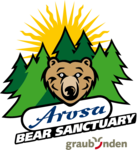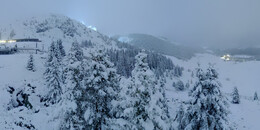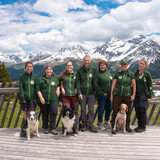FAQ
Frequently-asked questions
Visit
Yes, the ticket for the Arosa Bear Land is a one-day ticket. For re-entry, please contact the cashier or the staff on site.
Yes, the visitor platform and adventure trail are accessible by wheelchair. Would you like to explore Arosa and the Arosa Bear Sanctuary in an all-terrain wheelchair? Then click on the following link and learn more.
About us
Over the past 20 years, FOUR PAWS has saved more than 120 bears and moved them to bear conservation centres run by FOUR PAWS or partner projects.
Segregation is necessary to satisfy animal health restrictions and to prevent the transfer of possible illnesses to local wild animals.
The Arosa Bear Sanctuary is operated by the Arosa Bären Foundation The Foundation Council consists of representatives from FOUR PAWS, Arosa Tourism and the Arosa Mountain Railways. The Arosa Bear Sanctuary is primarily a cooperation project between FOUR PAWS and Arosa Tourism.
The bears have a total of 28,000 m2 at their disposal (2.8 ha). If necessary, the enclosure can be split into two sections of 12,000 m2 and 16,000 m2. The five available shelters are each 10 m2 (2.5 m x 4 m), the indoor enclosure approx. 164 m2 + 52 m2 and the outdoor enclosure approx. 1.6 ha (South) and approx. 1.2 ha (North).
Here is a little story...
An old man walks along a beach. The water flows away in the ebb tide. There he sees in front of him a younger man who picks something up from the beach and throws it into the sea. At first the old man thinks that it is probably sea shells or stones. But as he draws nearer, he sees that the young man is picking up starfish and throwing them back into the sea.
Thereupon, he asks the young man what he is doing there. He says: “I am saving the lives of the starfish.” The old man looks around and says: “But can’t you see how very long this beach is - you can't possibly save all the starfish. So what you are doing doesn’t make any difference at all.”
The young man answers: “It’s true that I can’t save them all.” He bends down, picks up another starfish and throws it into the sea. “But it makes a big difference to this one.”
Bears
Brown bears are naturally adapted to an Alpine climate. Until the end of the 19th century, brown bears lived throughout the Graubünden region and also in Arosa. Place names in Arosa such as Bärenbad, Bärenried and the Bärental valley bear witness to this.
The life expectancy of a brown bear is around 30 years.
Brown bears have one change of coat per year, in summer. So brown bears do not have a specific summer or winter coat (as wolves do, for example). It is quite normal that the new hair is rather dark at first and then, with time, particularly in spring, it can become very light. This is different for each individual. Why the hair is generally darker in winter and then becomes light in spring is as yet unclear. (Possible explanation: sunlight bleaches the hair)
As a matter of principle, males are neutered at all FOUR PAWS rescue centres. The females are also sterilised in Arosa to prevent them attracting wild bears.
The behaviour of brown bears is geared towards building up fat reserves during the food-rich time in summer so that they can survive the food-scarce time in winter. So that as little energy as possible is consumed in winter, the bears lower their metabolism during late autumn. They reduce their appetite, reduce their activity and only eat what they can find with the least effort. When there is no more food, they start hibernation and use as little energy as possible. This metabolic cycle is inherited, in other words, it is innate.
The abused bears also inherently reduce their metabolism in winter. However, as they were previously fed by their former owners in winter and had no opportunity to withdraw (to caves), as is typical for bears, they remained active at a low level and could be observed by the visitors. At the Arosa Bear Sanctuary, we stop feeding at the start of winter, as is the case in nature, and suitable caves are available. During this period, and in this situation, the bears start their hibernation as inherently predetermined.
Other questions
Any more questions? We are happy to advise you by telephone or by mail.











